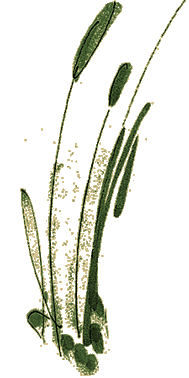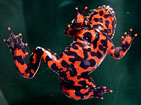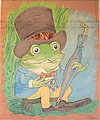
|

|

hroughout the exhibition were terrariums housing unusual frogs
- animals that have adapted their behavior for survival -- to
protect themselves from harsh climates, for instance, or as a
defense against their enemies.
|

|
The Surinam
toad, who lives in water, protects her young by carrying the eggs
and tadpoles embedded in the skin of her back, until they hatch
as tiny, fully formed toadlings. The fire-bellied toad, whose dull
brown back matches the ground cover of its native habitat, warns
away potential predators by flashing its brilliant scarlet underside.
The Asiatic horned frog has camouflage so incredible it seems to
disappear against a leaf.
|

|

|
|
|
The
underside of the fire-bellied toad
(
Bombina
orientalis.
)
[
Click
for a larger image.] Photo by
Amy Snyder.
|
|
|
|
Frogs
are remarkable creatures, but there is a limit to the conditions they
can adapt to. The clearing of the rain forests is destroying the habitats
of countless species. A frog's moist, permeable skin makes it vulnerable
to pesticides and herbicides, high concentrations of fertilizers, changes
in the ozone layer, and fungal and viral infections. Frogs are disappearing
all over the world.
|

|

|
"Mr.
Toad," from the online feature
Frog
City
. Photo by Amy Snyder. [
Click
for a larger image.]
|
|
Frogs in Popular Culture
Frogs and toads don't look anything like us, but we "humanize" them
nonetheless, creating familiar storybook characters from the Frog Prince
to Mr. Toad of Toad Hall. This cultural aspect of our relationship with
frogs and toads was exhibited throughout the show, with selections from
literature, images from cultures around the world, and whimsical toys,
from Beatrix Potter's Jeremy Fisher to stuffed amphibian Beanie Babies.
Visitors could read about Mark Twain's experiences in Calaveras County;
hear Kermit the Frog singing "It's Not Easy Being Green," or sit nose-to-nose
with live frogs and toads and really get to know what remarkable animals
they are.
The
Frogs
website is a permanent resource, and will remain online, featuring articles,
interactive exhibits and hands-on activities.
©
1999,
The Exploratorium
|




